Obtaining and Handling Logs
Sawmill operators discuss ways to get free logs from contractors clearing land, and ways of loading and transporting the logs. August 31, 2005
(Sawing and Drying Forum)
From contributor D:
I had an idea that has paid off. I wrote a quick note to local excavating contractors introducing myself and letting them know I have a small sawmill. I explained I was always looking for logs and would like to work with them if they are clearing virgin timber (they just push trees into a pile and burn them). Two days later, I got my first call. The guy said he was taking out a couple of trees I may want - to come and get them. He was glad to get rid of them - "Darn things would have burned for a week, and I need to get this job done." I took away his matches and gave him a card and told him to call me every time he has more of those darn things. He loaded them onto my trailer. 1 trailer was a red oak, 44"x 11'. The other trailer was all walnut, a few decent ones 24"-34" x 8' and several smaller ones that I would not have cut. But instead of let him burn them, I will get what I can on the saw. I got a nice stack of 16" wide clear walnut boards.
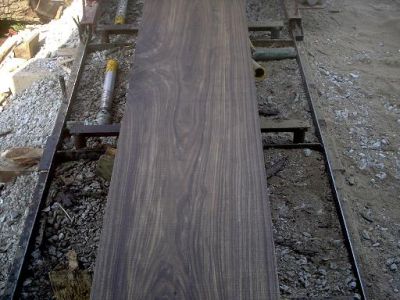
Here is a picture of the little stack I got off one log he was going to burn. I have 20 more ready to saw and whatever I can get out of the red oak (800-900 bft?) by the time I butcher it to get it on my little mill in 1/4.
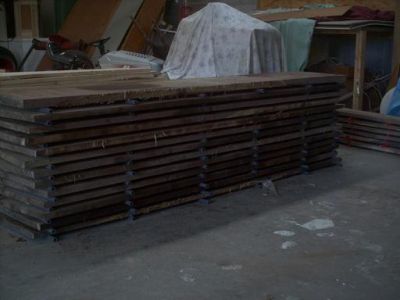
From contributor K:
I'm offered logs every now and then, but all I have is an F150 pickup, and a 16' trailer. I'm usually left to load the logs and unload them. I end up turning most of it down, because I just don't have a bobcat, or anything to load with. I can probably drag them out of the trailer, if I put a winch on the front of my truck, but the loading is a stumper for me.
From contributor R:
Loading is actually the relatively easy part. I have loaded some really big logs by rolling them up a ramp on the side of the trailer.
The procedure I use is:
Park the trailer parallel to the log, about 8-10 feet away.
Take a number of 4x4's about 8' long (I usually get by with 2, but I only have a 10' trailer) and put one end on the edge of the trailer, and the other end on the ground beside the log.
Hook a log chain to the ends of the trailer on the side opposite the log.
Connect a winch or come-along to the middle of the trailer, on the opposite side of the log.
Run the cable over the top of the log, around the back, under the log and then connect it to the middle of the chain.
Use the winch to roll the log up the ramps and onto the trailer.
I had a 12' long, 36" log on the trailer using this method, then the trailer axle broke...
From the original questioner:
My mill is in town. My shop is across the alley from a lawnmower/auto shop with a forklift. The city street department and I share the block, and they have a backhoe. My buddy who is a backhoe operator has 3 backhoes, 1 trackhoe and 2 bobcats and is 4 blocks away. I am on the edge of town. The rural road shed is also 4 blocks away. They have 2 backhoes and a big endloader. With all that, I have had logs I couldn't move because everyone was gone at once. I broke down and bought a small Bobcat with a grapple bucket. I don't usually take huge logs, as they can be more work than they are worth. 36" and under… Heck, the majority don't even grow that big around here. I swear under my breath when I see a 48" roll in and know I am going to have to 1/4 it.
From contributor K:
Do they make a bobcat small enough that I could drive it up onto the back of my pickup for traveling, yet strong enough to load and unload logs?
From contributor D:
I am not all that knowledgeable about equipment. But I do know the one I am getting weighs 3500lbs even though it is small. I think the weight of the machine is important for offsetting the log's weight. You would need something a lot heavier than the log to pick it up. I don't think you want that in the bed of the truck. You can still get a decent pile of logs and a small bobcat on a trailer. I don't even chase logs - the one I have is for use around the mill. I have only been doing this since last November and with no adverts, I usually have as much as I can saw brought to me. If there are free logs I can't pass on, there is a guy here in town who is semi-retired that chases for me. He ran after the walnut and oak for something to do, and he heats with wood so he likes to see me sawing 'cause he takes a lot of the scrap.
From contributor D:
Another idea if you are only looking at 1 or 2 logs at a time... You live in Illinois, right? Call the Illinois Propane Gas Association. I had talked to a guy one time when I was thinking about a way to move logs without a loading machine. They have special wagons for moving propane tanks that you pull over the tank, crank it up, then drive off with it. He is in the know with all the gas distributors through the state, and usually knows where a guy can pick one of those things up used.
From contributor J:
A bobcat that will lift 2000lbs weighs about 10,000 lbs.
From contributor K:
Yes, in northern IL. Is that legal to drive down the highway with a log chained under such a carriage?
From contributor D:
I would think it would be less of a hazard than 500 gallons of liquid propane. I'm not a cop, but I think with proper flagging it should not be a problem. It's rural here - you see a little of everything going down the road. Sometimes there is more farm equipment than cars. So a log going down the road would not even get a second look.
The one I am familiar with is one my uncle used in his propane and fuel oils distribution business when I was a kid. I would help him sometimes during the summer. He sold out and retired years ago, and I don't know what became of his. It would have made a better log hauler than the one I linked to, but they are out there. That office I mentioned before is in Springfield, but the rep travels the whole state.
From contributor A:
I have hired a flatbed from a local towing company to recover logs. The going rate is 75 to 100/hr. If I have the logs lined up and trimmed of branches, they can back right up and use the winch to pull them up on the bed, then I roll them off in my yard where they get sawn.
From contributor S:
We haul logs regularly with a tandem axle trailer using a parbuckle technique to load. If it's a whole lot of logs, we hire a truck.
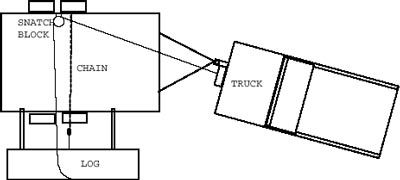
Image by Scott Banbury of www.scottbanbury.com.
From contributor H:
Those trailers you talked about moving propane tanks don't leave the tank dangling. They hoist up the tank, then put two pieces of curved iron (to fit the tank - one near each end) under it, then let the tank down on the iron. You could do the same for logs.
From contributor E:
Got real lucky last weekend and picked this up for $55.00 at a farm auction. Hope it helps with what a towable log hauler should look like.
I parked it over a spare log deck and am happy to see that I will be able to back the log over the deck and drop it where it needs to be sawn.
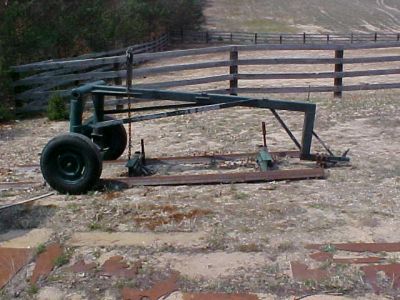
From contributor B:
Here is what I use and it works spectacularly. I pull up near the tree and unhook my trailer, back up to the tree, pick it up so it will clear the side of my trailer and then throw another chain around the log and hook it to the two blue chain hooks on the back side of my truck, pulling it up snug. I then chain the other side likewise and I can drive with the log without it swaying and swinging all over. I back up to the trailer, unload and reverse the process when I get home to set it on the mill. In the picture, I have wrapped the chain around the log twice and as I lift, I can turn the log to position it (that is a 24+" post oak 16' long.) My winch setup is mounted on a 3'x4'x3/8" plate of steel that is bolted to my p/u frame. It will slide right out if I need the regular p/u bed. Total cost about $2500 - and it will pick up more than most bobcats and is probably cheaper.
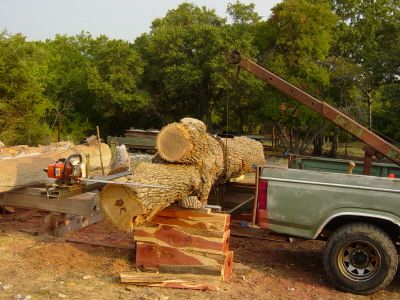
From contributor T:
Future Forestry manufactures a line of arches for moving and transporting logs. They're very simple to use and affordable.
The comments below were added after this Forum discussion was archived as a Knowledge Base article (add your comment).Comment from contributor M:
I use an open 6' X 10' tandem axle trailer with a 3' foot ramp (I bought from a lawnmower and boat trailer manufacturer) with a winch mounted on a standard vertical post used for boat winches. The post mounts on the trailer tongue, just as it does on any boat trailer. Any winch can mount on the top of the post with minimal drilling. I bought a Ramsey 8000 lb winch and a snatch block from Northern Tool Supply. I also purchased the Ramsey Mounting plate, which mounted to the post after drilling four holes. I use a choker cable around the log with a snatch block hooked to it. The winch cable runs from the winch, through the snatch block, and back up to the front of the trailer, where I hook it to the tongue. Using the snatch block doubles the capacity of the winch and, obviously, allows it to pull large logs at half the load.
Trailer: $1400 new, winch $400 new, winch mounting plate $80.
It is fun to use, because three large logs can be easily pulled up the ramp and into the trailer bed, sitting alongside each other. Two more medium sized logs can be pulled up on top of the original three by removing the trailer ramp (pulling it off of its hinge pins) and leaning it lengthwise up against the logs already on the trailer. I usually can pull the following two logs up on top of the originals without much trouble.




